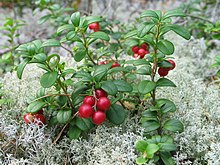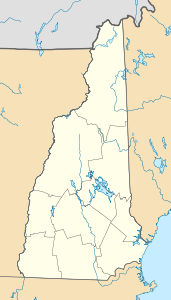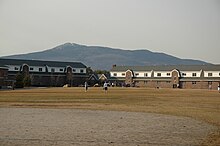Mount Monadnock
| Mount Monadnock
Grand Monadnock
|
||
|---|---|---|
|
Rock plateau on the summit |
||
| height | 965 m | |
| location | New Hampshire , USA | |
| Notch height | 655 m | |
| Coordinates | 42 ° 51 '39 " N , 72 ° 6' 29" W | |
|
|
||
| Type | Littleton formation | |
| rock | Mica schist / quartzite | |
| Age of the rock | 400 million years | |
| First ascent | 1725 (Captain Samuel Willard) | |
| Normal way | White Arrow Trail (3.7 km) | |
Mount Monadnock , or Grand Monadnock , is the most prominent mountain in New England south of the White Mountains and east of the Berkshires , Massachusetts . With a height of 965 m, Mount Monadnock is over 300 m higher than any other elevation within a radius of 48 km and over 600 m higher than the immediate vicinity. The mountain is about 100 km northwest of Boston in the south of the state of New Hampshire .
The mountain gives its name to the geological term Monadnock , which is used as a synonym for Inselberg .
The mountain is located in Mount Monadnock State Park . A number of hiking trails lead up the mountain.
Surname
The word Monadnock is derived from the Abenaki language and describes a mountain. Loosely translated, it means "mountain standing alone", although the exact meaning of the word, i.e. what kind of mountain it is, is uncertain. The term was used as an alternative word for Inselberg by early settlers in southern New Hampshire and later by American geologists . To distinguish Mount Monadnock from other mountains with similar names in Vermont and New Hampshire , it is also often called Grand Monadnock .
history
The transcendentalists
Both Ralph Waldo Emerson and Henry David Thoreau visited the mountain and wrote about it lovingly. Emerson came regularly and dedicated his poem "Monadnoc" to him. Thoreau came to the mountain a total of four times from 1840 to 1844, and spent much of his time observing and cataloging natural phenomena . According to popular opinion, he wrote one of the first serious works about the nature of the mountain. A bog near the summit and a rocky lookout point on the Cliff Walk trail are named after him; another lookout point is named after Emerson .
The halfway house and other structures
In 1858, Moses Cudworth from Rindge opened The Half Way House hotel on the south side of the mountain, about halfway from the base to the summit. The Toll Road was built to supply the hotel . At that time, the mountain was extremely popular, so that Cudworth had to expand his hotel after a short time to accommodate 100 guests. On busy summer days there were up to 75 horses in the hotel's stables.
The Halfway House became joint property when several hundred residents of the surrounding villages joined forces to buy the street and hotel and at the same time prevent the construction of a radio tower on the summit. After the hotel burned down in 1954, a kiosk was set up in the same place . When the street was closed to public traffic in 1969, the kiosk also closed. The Moses Spring , whose source lies in a hole carved through a rock at the rear of the property, is one of the last few remaining references to the hotel's years of operation.
A small hut for the local fire brigade was right on the summit and was in operation from 1911 to 1948. It was closed when forest fires could be more easily detected thanks to modern technology. However, the hut itself remained in operation as a snack bar and accommodation for hikers until 1969, when it was demolished in 1972.
A private residence 100 ft (30.48 m ) south of the former hotel's property is the last remaining structure on the mountain above 1,000 ft (304.8 m ).
Ascents
The first recorded ascent of Mount Monadnock was in 1725 by Captain Samuel Willard and 14 rangers who camped on the summit and used it as a vantage point while patrolling for Indians . Many of the hikers initially scratched their names on the summit until this practice was frowned upon. The oldest engraving reads “S. Dakin, 1801 ”and is attributed to a local city worker.
The athlete Garry Harrington hiked a total of 16 times in 24 hours, while Larry Davis hiked to the summit once on 2,850 consecutive days (this is 7.8 years).
It is often claimed that Mount Monadnock is the second most climbed mountain in the world after Mount Fuji in Japan . In fact, the mountain is climbed by 125,000 hikers annually, while around 200,000 hikers commit Mount Fuji. According to UNESCO , however, no mountain comes close to the popularity of Tai Shan in China , which has to cope with more than 2 million visitors annually.
Biogeography, Ecology and Geology


Due to fires in the early 19th century that burned much of the top around 300 ft (91.44 m ) in diameter around the summit, there is only a thin layer of soil there today. Although the mountain has recovered enough that the landscape looks natural, Mount Monadnock is an example of a mountain with an artificial tree line that is well below the natural climatic limit of comparable mountains in the region.
On the way from the base to the top, the number of plant species decreases as the layer of soil becomes thinner. There are a variety of specialized, sub-alpine species on the summit that can hold moisture for a long time. Among the occurring alpine and sub-alpine species are whitebeams , cotton grasses , sheep's laurels ( Kalmia angustifolia ), greenland chickweed ( Minuartia groenlandica ) and lingonberries . There is also a lot of Krummholz and some moors . The lower altitude areas are densely overgrown with mixed forest, in the middle areas there are also some stands of American red spruce . Before the fires, the entire mountain was covered with these trees, and since then these trees have been slowly advancing towards the summit via the process of succession .
The mountain consists largely of 400 million year old, highly metamorphic rocks of mica schist and quartzite , predominantly associated with the Littleton Formation , a geological layer from the Devonian Mountains that extends from Massachusetts in the south to the White Mountains in the north becomes. At lower altitudes on the mountain and in relation to the geological layers below the Littleton Formation , the rock comes from the Silurian and consists of mica schist from the Rangeley Formation , quartzite from the Perry Mountain Formation , granulite from the Francestown Formation and granulite from the Warner Formation .
Structurally, the mountain is part of an upside-down syncline (known as the "folded tectonic blanket ") formed by the compressive forces of Acadian orogeny . Very small to medium-sized metamorphic folds can be observed on many stone surfaces on the mountain, including the well-known Billings Fold about 450 ft (137.16 m ) west of the summit, which was described in 1942 by Marland Pratt Billings in his book Structural Geology .
In addition to the impressive folds, there are also large pseudomorphic specimens of sillimanite and andalusite . These crystals, which are usually as thin as a needle, appear here as 4 in (101.6 mm ) long “turkey tracks”, which were created by prograde metamorphosis .
Hydrology
The Mount Monadnock is on the dividing line of the river basins of the Connecticut River and Merrimack River . The northern reaches of the mountain drain into Howe Reservoir and then via Minnewawa Brook into the Ashuelot River , the Connecticut River, and finally into the Long Island Sound . The Gleason Brook and Mountain Brook flow on the west side of the mountain over the Shaker Brook into the southern branch of the Ashuelot River . The southwestern areas of the mountain also drain into the southern branch of the Ashuelot River via the Fassett Brook and Quarry Brook .
In the southeast of the mountain, the Mead Brook and Stony Brook flow into Mountain Brook , a tributary of the Contoocook River that drains into the Gulf of Maine via the Merrimack River . The eastern areas of the mountain drain into Thorndike Pond , from where the Stony Brook flows northeast into the Nubanusit Brook and then into the Contoocook and the Merrimack .
Leisure and recreational opportunities
The Mount Monadnock offers numerous opportunities for hiking , trekking , picnicking and hiking with snowshoes . In winter there are also remote areas where skiing is possible. A New Hampshire state campground is seasonally operated on the southeast side of the mountain - camping is not permitted anywhere else. During the season, a fee per person is charged to park on Old Toll Road or at the park administration headquarters. There is no road to the summit, and the Old Toll Road , which leads to the remains of the Halfway House , is closed to vehicles. Quads are generally not allowed on the mountain. In particular, New Hampshire Route 124 offers good views of the mountain and its immediate surroundings.
Hiking trails
The Mount Monadnock is a dense network of well-kept trails through it. The most famous routes are the 2.2 mi (3.54 km ) shortest and steepest route, the White Dot Trail on the southeast side, and the 2.3 mi (3.7 km ) long White Arrow Trail , which is considered the easiest route over the Old Toll Road on the south side of the mountain.
Other hiking trails include:
- The Marlboro Trail on the west side, 2.2 mi (3.54 km ) to the summit
- The Dublin Path on the north side is part of the Monadnock-Sunapee Greenway , 2.4 mi (3.86 km ) to the summit
- The Pumpelly Trail on the northeast side has the longest climb, 4.4 mi (7.08 km ) to the summit
- Access on the east side of the mountain is made possible by the Birchtoft Trail and several connecting paths to the summit.
The White Cross Trail is a parallel alternative to the White Dot Trail , and the Cliff Walk offers special scenic impressions. The Mount Monadnock is the northern end of the 110 mi (177,03 km long) Metacomet-Monadnock Trail , however, is difficult to access, leading to the southwest side of the mountain due to lack of parking. The mountain also represents the southern end of the 50 mi (80.47 km ) long Monadnock-Sunapee Greenway , which runs north to Mount Sunapee . The project also aims the Wantastiquet-Monadnock Greenway from the fact that Mount Monadnock to the Pisgah State Park and the Wantastiquet Mountain to join.
Hiking on the mountain
The approximately four-hour circular route to the summit and back via one of the shorter hiking trails makes moderate demands on the average hiker and does not require any technical skills from late spring to early autumn. Wind and weather are stronger all year round on the rocky summit than at lower altitudes, and hurricanes and summer thunderstorms can be life-threatening there.
In winter snow and ice lie on the hiking trails until May and make the ascent or descent very dangerous or even impossible without special technical equipment. Above all, the increased compaction of the snow on the trails, which are also used more frequently in winter, ensures that it stays there longer than elsewhere. Therefore, at this time of the year, depending on the thickness of the snow and ice cover still lying on it, hiking sticks, crampons , ice axes , ski poles and snowshoes may be helpful or even necessary.
In autumn, hikes require warmer clothing, careful weather observation, and earlier ascent times. Because there are few reliable sources of drinking water on the mountain and little protection from the sun above 2,000 ft (609.6 m ), dehydration and heat stroke are potential risks. Poison ivy does not grow on the mountain, and there are no poisonous snakes either. However, American black bears live on the mountain and in the surrounding area , although problematic encounters between humans and bears are rare.
Artistic contributions

In addition to Emerson and Thoreau , other artists were also inspired by Mount Monadnock , including:
- William Preston Phelps (1848–1917), known as "the painter of Mount Monadnock".
- Many other American painters immortalized the mountain in a painting. These include Abbott Thayer , Rockwell Kent and Richard Whitney , among others .
- The American composer Alan Hovhaness (1911–2000), who climbed the mountain several times in his youth, composed a symphonic fantasy around 1935 entitled Monadnock , Op. 2.
- The writer HP Lovecraft wrote a poem about the mountain called "To Templeton and Mount Monadnock".
- Pulitzer Prize- winning poet Galway Kinnell wrote about the mountain in his poem "Flower Herding on Mount Monadnock".
- Part of the annual Mount Monadnock Celebration of Dance takes place at the top of the mountain at the time of the autumn equinox .
Individual evidence
- ^ Devonian Period. (No longer available online.) New Hampshire Geology, archived from the original on April 29, 2012 ; accessed on August 8, 2012 . Info: The archive link was inserted automatically and has not yet been checked. Please check the original and archive link according to the instructions and then remove this notice.
- ↑ a b c d e f g h i j k Henry Ives Baldwin: Monadnock guide . Ed .: Society for the Protection of New Hampshire Forests. Society for the Protection of New Hampshire Forests, Concord, NH 1970, OCLC 129697 .
- ↑ Ralph Waldo Emerson: Monadnoc. Retrieved August 8, 2012 .
- ↑ 10 Fun Facts. (No longer available online.) Archived from the original on July 31, 2012 ; accessed on August 8, 2012 . Info: The archive link was inserted automatically and has not yet been checked. Please check the original and archive link according to the instructions and then remove this notice.
- ↑ More than a Mountain. (No longer available online.) Archived from the original on July 30, 2012 ; accessed on August 8, 2012 . Info: The archive link was inserted automatically and has not yet been checked. Please check the original and archive link according to the instructions and then remove this notice.
- ↑ Wayne Brink: Hiking Mt. Monadnock, NH. June 18, 2008, accessed August 8, 2012 .
- ^ The People's Republic of China. (PDF; 674 kB) Mount Tai. UNESCO, p. 17 , accessed on August 8, 2012 (English).
- ↑ Henry I. Baldwin: The Induced Timberline of Mount Monadnock, N. H. In: Torrey Botanical Club (Ed.): Bulletin of the Torrey Botanical Club . tape 104 , no. 4 . Torrey Botanical Club, ISSN 0040-9618 , OCLC 1639180 , p. 324-333 .
- ↑ Chet Raymo, Maureen E. Raymo: Written in stone . a geological and natural history of the northeastern United States. Globe Pequot Press, Chester, Conn. 1989, ISBN 0-87106-680-7 .
- ^ Peter J. Thompson: Geology of Mount Monadnock, New Hampshire . In: David P. West, Richard H. Bailey (Eds.): Guidebook for geological field trips in New England . 2001 Annual Meeting of the Geological Society of America, Boston, Massachusetts. Geological Society of America, United States 2001, OCLC 48434438 .
- ↑ Peter J. Thompson, Christopher J. Ryan: Monadnock Mountain, New Hampshire . US Geological Survey, Reston, Va. 1984, OCLC 46868748 ( USGS map ).
- ^ Monadnock State Park. (No longer available online.) The New Hampshire Division of Parks and Recreation, archived from the original June 6, 2012 ; accessed on August 9, 2012 . Info: The archive link was inserted automatically and has not yet been checked. Please check the original and archive link according to the instructions and then remove this notice.
- ^ Walter Banfield et al .: Metacomet-Monadnock Trail guide . Ed .: Trails Committee of the Berkshire Chapter. Appalachian Mountain Club, Amherst, MA 1995, ISBN 0-9624801-8-5 .
- ↑ Jeffrey Nugent: Daniels Mountain. Area's Newest Trail. (No longer available online.) In: Brattleboro Reformer. May 2001, archived from the original on July 23, 2008 ; accessed on August 9, 2012 . Info: The archive link was inserted automatically and has not yet been checked. Please check the original and archive link according to the instructions and then remove this notice.
- ↑ Appalachian Mountain Club (Ed.): Southern New Hampshire trail guide . Appalachian Mountain Club Books, Boston 1995, OCLC 317480947 .
- ^ Monadnock Poetry. (No longer available online.) Archived from the original on July 31, 2012 ; accessed on August 9, 2012 . Info: The archive link was inserted automatically and has not yet been checked. Please check the original and archive link according to the instructions and then remove this notice.
- ↑ Richard Ellmann, Robert O'Clair: The Norton anthology of modern poetry . 2nd Edition. Norton, New York 1988, ISBN 0-393-95636-9 .
Web links
- NH Division of Parks & Recreation: Monadnock State Park
- Mount Monadnock State Park Trail Map
- Metacomet-Monadnock Trail .
- Monadnock Conservancy
- Monadnock-Sunapee Greenway Trail Club
- Monadnock Mountain in the United States Geological Survey's Geographic Names Information System
- US Congress New England National Scenic Trail Designation Act.
- Mount Monadnock on Peakbagger.com (English)






